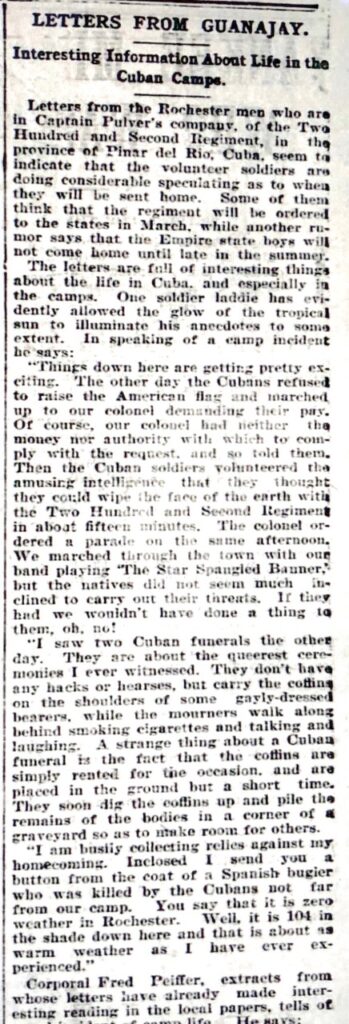
Spanish-American War Burial
The tour stop at Rapids Cemetery indicating a link to the Spanish-American War of 1898 is actually mistaken. There is no known burial here of a Spanish-American War veteran. The connection is based solely on the existing artifact of a duplicate military headstone for Frederick L. Peiffer which is visible at Rapids Cemetery. Here is a tribute to his remarkable life. The First U.S. Volunteer Cavalry Regiment led by Teddy Roosevelt was one of three regiments participating in the Spanish-American War fought in Cuba. Frederick L. Peiffer served as a sergeant with the 202nd Regiment Infantry New York Volunteers.
Frederick L. Peiffer (1878-1968)
The photo below of the intact headstone for Frederick L. Peiffer marks the verified burial spot at Mount Hope Cemetery in the Spanish-American War Veterans Plot (Gr. 78-R-130.5). The date of death indicates the year 1968. This was more than a quarter century after the last official burial at Rapids Cemetery when the burial grounds were already in a sad state of neglect.The obituary confirms that Frederick L. Peiffer was buried at Mount Hope Cemetery in 1968 at age 89.
The broken Frederick L. Peiffer headstone is visible at Rapids Cemetery. Notice that the date of death is absent. He is actually buried not far away at Mount Hope Cemetery. The presence of this headstone is a mystery. Local municipal cemetery officials theorize that the incomplete headstone, lacking the year of his death, may have been entrusted to the family for proper disposition. Somehow it found a home at Rapids Cemetery.
The combined files for Frederick L. Peiffer include several notes of distinction. In 1896, as a teen-ager, he bicycled the unpaved 412-mile length of the Erie Canal with his brother and two other cyclists. He served as a sergeant during the Spanish-American War and his accounts were published in the local newspaper. As a member of the Unique Social Club he was active in excursions, masquerade balls, sleigh rides and picnics. During the Second World War he was registered at age 63 in the ”Old Men’s Draft” for men who were between the ages of 45-to-64 years old at that time. He was active in local politics.

Actual Frederick L. Peiffer burial confirmed at Mount Hope Cemetery 
Mystery headstone 
Frederick L. Peiffer in 1952 at age 74 
Frederick L. Peiffer obituary
Frederick and his brother Charles made the remarkable, for its time, journey of the full-length of the Erie Canal using an unpaved route in 1896. They represented the Press Cycle Club of Rochester made up mostly of Rochester Democrat & Chronicle employees.

Rochester Democrat & Chronicle Sunday, June 23, 1946. page 20
Frederick Peiffer’s military involvement spanned 1898-to-April 1899. He was elected in 1904 as an officer in the local command of the Spanish-American War Veterans. Wartime letters from Frederick L. Peiffer published in the local newspaper. Image #1: Rochester Democrat & Chronicle: Monday, January 23, 1899. page 11 Image #2 (Newsy letter): Rochester Democrat & Chronicle: Sunday, February 5, 1899 Image #3 Rochester Democrat & Chronicle: Sunday, February 12th, 1899. page 9 (Guanajay, part 1) Image #4 Rochester Democrat & Chronicle: Tuesday, April 18th, 1899. page 13 Image #5 Continuation of Guanajay article, part 2)
After the United States entered World War II, a new Selective Service Act required that all men between the ages of 18 and 64 register for the draft. The Fourth Registration, or Old Man’s Registration, was held on April 27, 1942. The purpose of this registration was to collect information on the industrial capacity and skills of men who were born between April 27, 1877 and February 16, 1897 (ages 45 to 64). It was not intended that these men be drafted into military service but to determine if their labor skills could be used in the war effort. The registration would provide a complete inventory of manpower resources in the United States. The men had to fill out an extensive questionnaire, but unfortunately, the questionnaires have not survived. https://www.newberry.org/old-mans-draft









